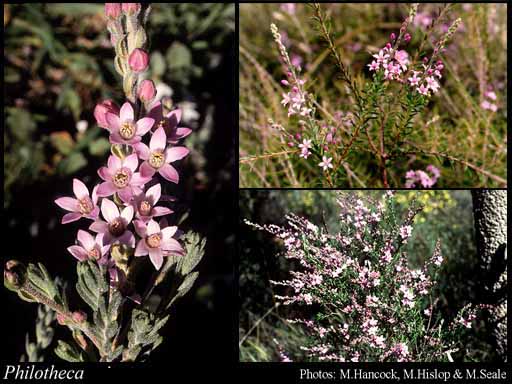- Reference
- Trans.Linn.Soc.London,Bot. p298, t. 21. (1816)
- Name Status
- Current

Scientific Description
Family Rutaceae.
Habit and leaf form. Shrubs; evergreen, or deciduous; bearing essential oils. Mesophytic, or xerophytic. Leaves alternate (semi-terete or rarely flattened); fleshy; petiolate; non-sheathing; gland-dotted; aromatic; simple, or compound; when compound ternate, or pinnate, or bipinnate, or unifoliolate. Leaf blades when simple dissected, or entire; when simple/dissected pinnatifid, or much-divided; pinnately veined, or one-veined. Leaves often with stipules, or without stipules. Stipules when present black, intrapetiolar; represented by glands. Leaves without a persistent basal meristem. Leaf anatomy. Hairs present, or absent; complex hairs present, or absent (then trichomes simple). Complex hairs stellate. Stem anatomy. Nodes unilacunar, or tri-lacunar. Secondary thickening developing from a conventional cambial ring.
Reproductive type, pollination. Fertile flowers hermaphrodite. Unisexual flowers absent. Plants hermaphrodite. Entomophilous.
Inflorescence and flower features. Flowers solitary, or aggregated in ‘inflorescences’; when solitary, terminal, or axillary; in cymes, or in racemes, or in fascicles (clusters). The terminal inflorescence unit cymose, or racemose. Inflorescences terminal, or axillary. Flowers bracteate; bracteolate (on pedicels), or ebracteolate (rarely); small to medium-sized; fragrant; regular, or somewhat irregular. The floral asymmetry when noticeable, involving the perianth and involving the androecium (not K). Flowers 5 merous; cyclic. Floral receptacle developing a gynophore (associated with the disk), or with neither androphore nor gynophore. Free hypanthium absent. Hypogynous disk present (narrow); intrastaminal; annular (sometimes one-sided), or of separate members. Perianth with distinct calyx and corolla; 10; 2 -whorled; isomerous. Calyx 5; 1 -whorled; polysepalous, or gamosepalous; lobed; glabrous; imbricate; regular; with the median member posterior. Corolla 5; 1 -whorled; polypetalous, or gamopetalous; imbricate, or valvate (rarely); regular, or unequal but not bilabiate. Androecium 10. Androecial members unbranched, or branched (? by the splitting of simple primordia); free of the perianth; all equal, or markedly unequal; free of one another, or coherent; when cohering, 1 - adelphous (united into a sheath below, slender-terete above); 1 -whorled, or 2 -whorled. Stamens 10; diplostemonous; alternisepalous. Anthers dorsifixed, or basifixed (? more or less); versatile; dehiscing via longitudinal slits; introrse, or latrorse; tetrasporangiate; appendaged; minutely apiculate (with or without glands at the base of the apiculum). Gynoecium 5 carpelled; apocarpous; eu-apocarpous; superior. Carpel stylate; with a lateral style (styles affixed to medial surface of inner margin of carpels, ovary with sterile apex); (1–)2–100 ovuled. Placentation of the free carpels marginal. Stigmas wet type, or dry type; papillate, or non-papillate; Group II type, or Group IV type. Ovules pendulous to ascending; epitropous; when two or more per cell, collateral, or superposed, or biseriate; arillate, or non-arillate; anatropous, or hemianatropous.
Fruit and seed features. Fruit fleshy, or non-fleshy; an aggregate. The fruiting carpel dehiscent, or indehiscent; baccate. Seeds reniform or ellipsoidal; endospermic, or non-endospermic. Embryo well differentiated. Cotyledons 2. Embryo chlorophyllous, or achlorophyllous; straight, or curved, or bent. Seedling. Germination phanerocotylar, or cryptocotylar.
Physiology, biochemistry. Aluminium accumulation not found. Photosynthetic pathway: C3.
Geography, cytology, number of species. N=14 or 28. A genus of 44 species.
Additional characters Petals shortly uninerved.